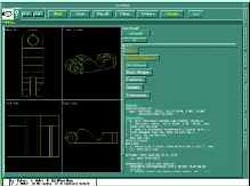NAC is iN-STEP
Along with other functions, the planning module in N-STEP lets users browse through feature trees to get familiar with the amount and type of features in a project.
The National Automotive Center (NAC), Detroit, an Army agency linking industry, academia, and the government in developing ground-vehicle technologies, is introducing N-STEP to the industrial commercial marketplace. N-STEP comprises a partnership of several organizations that communicate via an integrated data-management software program to handle manufacturing processes for re-supplying Army tanks.
N-STEP produces Standard for the Exchange of Product Model Data (STEP)-compliant files (part of international product standard ISO 10303) and provides a mechanism that describes part data throughout its life cycle, independent of particular software or hardware. The program aims to eventually provide a global standard for the exchange of product data in manufacturing-supply networks. STEP came about in the late 1970s and early 1980s to both standardize how product data is captured and displayed and to store more information than CAD files. This was necessary because companies were having trouble translating engineering data between proprietary CAD formats and other related data produced in computer-aided-engineering (CAE) or finite-element-analysis (FEA) software.
Another problem was CAD files did not contain all necessary partmanufacture information such as part features, dimensions, tolerances, and material requirements.
As the next-generation STEP, NAC has developed N-STEP to handle legacy data for the Army's older vehicle replacement parts. Most of this data resides in blueprints from the 1950s, '60s, and '70s that were hand-drawn or done in low-end 2D software. Because the prints were old and difficult to read, machinists often interpreted them incorrectly, which lead to a lot of scrap and wasted time re-machining parts.
N-STEP, however, reportedly keeps everyone on the same path. All legacy data resides in one format, parts get validated before manufacture, and a production plan is created prior to part routing. The program handles these functions in its software translation, validation, and planning modules.
First, personnel populate the software databases by entering tool lists, materials, machine tools, and quality standards. Once the databases are set up, individual order data is entered.
For example, NAC sent CAMP Inc., Cleveland, one of its N-STEP partners, the blueprint for a tank solenoid control-stop. CAMP handles the translation module, which takes the 2D drawing and makes it into a 3D model, with an engineer scanning the blueprint in and entering part number and name. He also enters information about part shape, and whether it's a casting or a forging.
For the stop, a prismatic shape, the engineer enters width, height, and length dimensions. This kicks off Pro-Engineer, with which the software interfaces, and applies tolerances. The user then creates all the features such as surface flats, grooves, holes, and chamfers on the model, creating a model tree. (The features store in a library for future use.)
The engineer then defines part attributes such as knurling or threads. The program executes, and the resultant 3D Initial Graphics Exchange Specification (IGES) file (AP224), usable across multiple CAD systems, is ready for validation.
In the validation module, another engineer examines the 3D model using rotation, panning, and zooming in various views to verify data, calculations, and input against the legacy print. He selects each feature to review dimensions, tolerances, and attributes and also looks at the model's base shape, material, and Geometric Dimensioning and Tolerancing (GT&D) data. If any feature fails, the software generates an error report, prohibiting a part going from design to manufacture until it is 100% correct.
The planning module is the final step prior to manufacturing. With it, the user completes tasks such as selecting raw stock, determining process operations, and assigning a machine or multiple machines. The planner also lets manufacturers optimize their machining processes with stored times and feedrates. In addition, it lets the user efficiently quote and bid jobs.
Another NAC partner in the N-STEP program is Onodi Tool & Engineering Co., Melvindale, Mich., which mainly does military work for General Dynamics, United Defense, and the U.S. government. In a pilot program, the company has used the planning module of N-STEP for about two years, running about 60 different parts such as housings and brackets through the program. CAMP handles the translation and validation modules for Onodi.
For more information on N-STEP, call (888)-801-CAMP or visit: nac-n-step.com.
